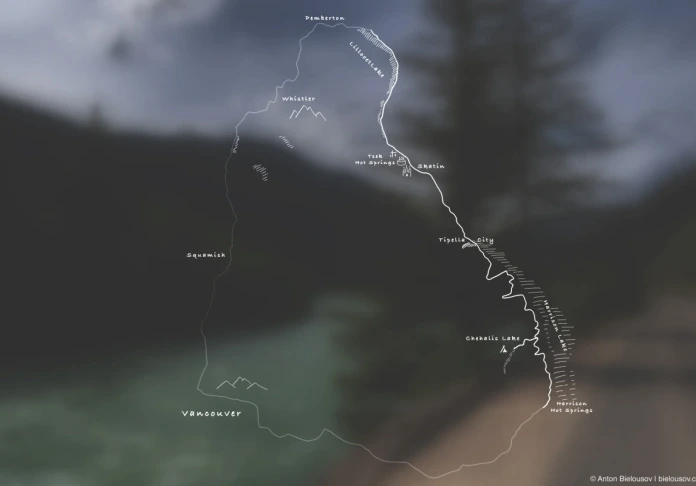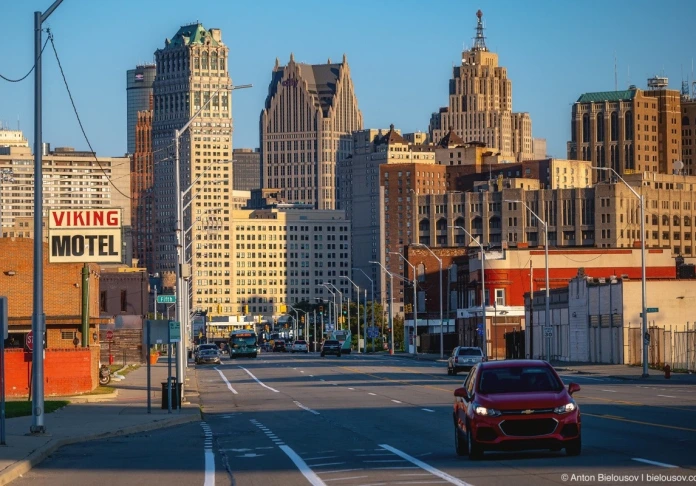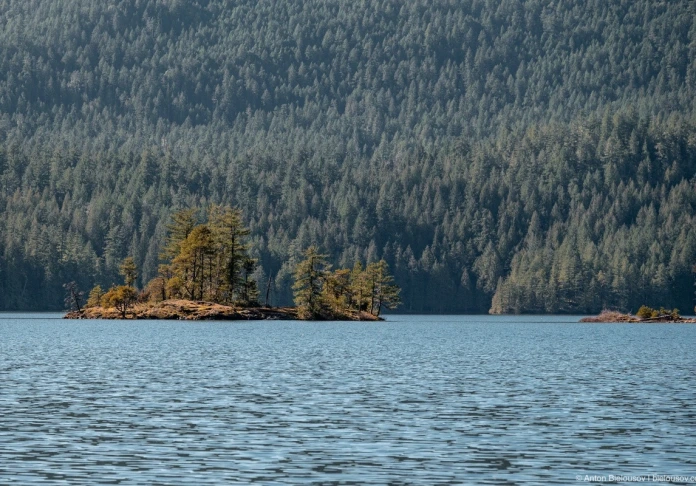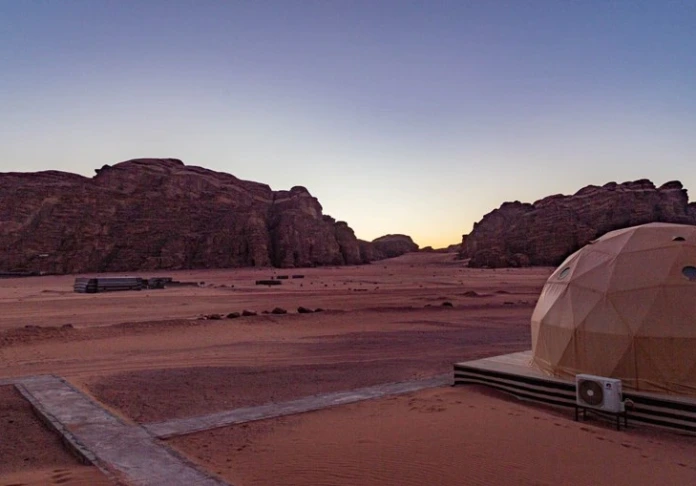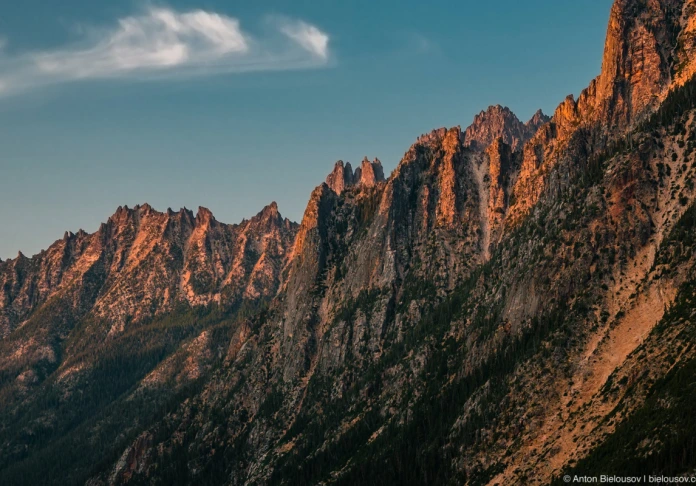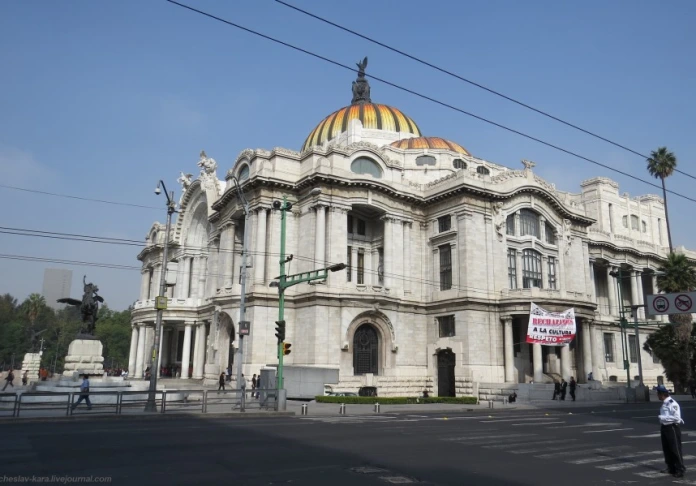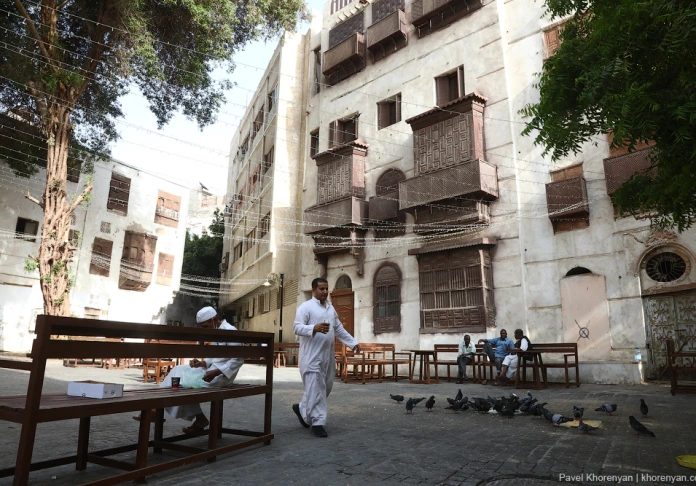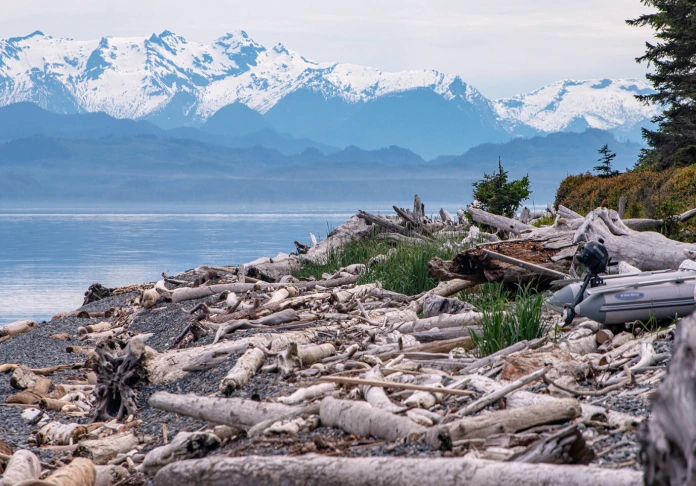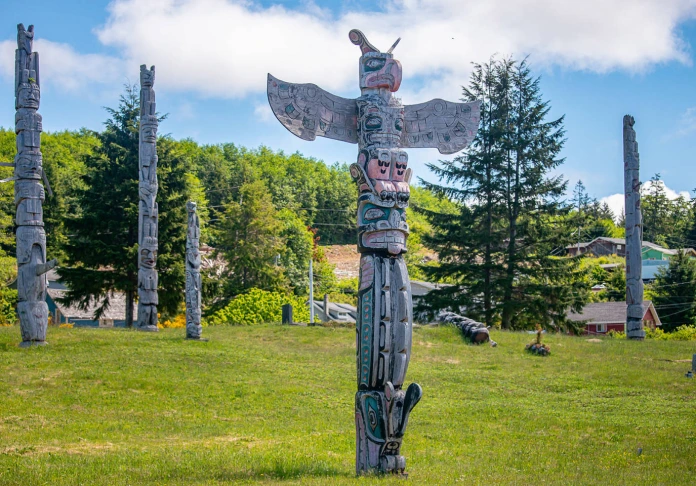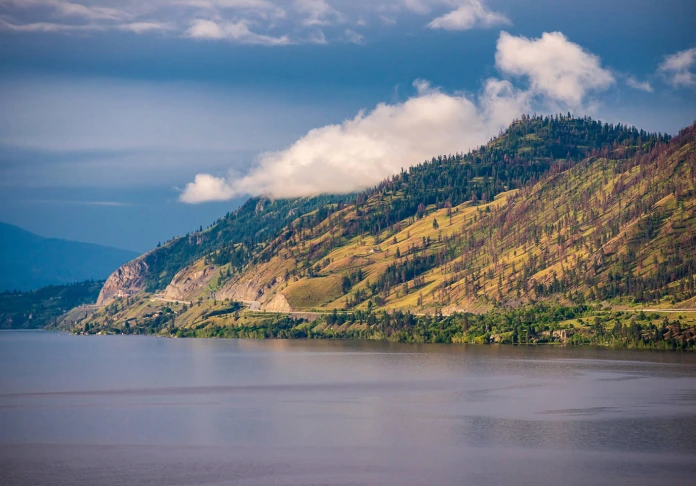Tirana
To visit the Albanian capital necessary to mentally prepare. I still remember my first shock from dirt, noise, lack of street signs and drivers dzhigits norovyaschih shoot down any pedestrian who dared to step into the roadway. Six months after returning from a trip I look at the pictures of Tirana and my memories seem far-fetched to me. Tirana - a dynamic city with a vibrant car traffic, with green boulevards, public parks, river shores in concrete and digital maps from Google. Only Photo rats along the river gives my memories certain truthfulness.
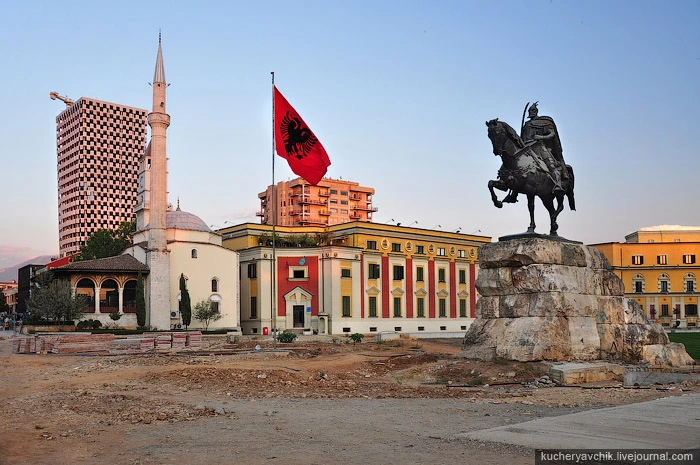
Skanderbeg Monument on the main square of Tirana. Tirana (Tiranё) became the first city I visited in Albania. Night bus from Macedonia dropped me off at half past four in the morning on one of the deserted streets of the Albanian capital. Place of disembarkation of passengers, though it seemed selected by the driver that night by chance, obviously guarded by a crowd of taxi drivers who persistently began to offer their services sleepy passengers, only started to get off the bus, and grab their hands to draw attention to himself.
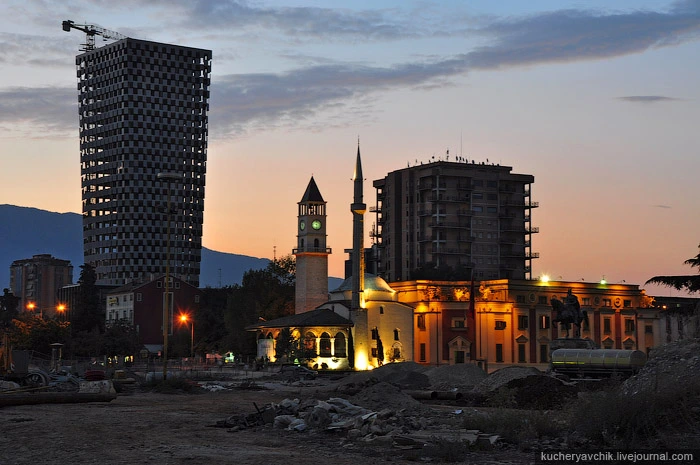
Skanderbeg Square, which I saw her at dawn. I was disappointed to learn that the main square of Tirana is under construction.
At night, slept Tirana. On the street, which led me to Skanderbeg Square, next to me ran a pack of stray dogs. The first impression is entirely coincided with the well-known stereotype of Albania in Europe.
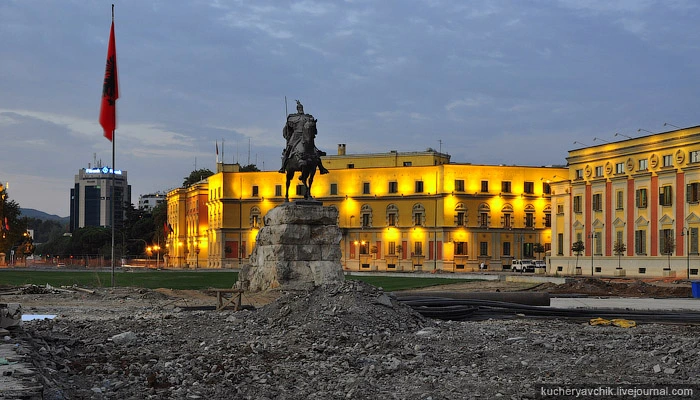
Skanderbeg Monument on the main square of Tirana. Skanderbeg - the national hero of Albania. About his participation in the formation of the Albanian national idea, I wrote in a report from the fortress of Kruja.
Skanderbeg Square in classical style main squares of all totalitarian states. In these countries, the task of the central square - to create the illusion of importance and prosperity. A huge area does not produce a sense of integrity, as its shape was formed over decades. Here are collected the modern opera house, a museum of history, ancient mosque Ethem, a monument to national hero Skanderbeg, three-storey building of government and fifteen-hotel "Tirana International". Each of these buildings were constructed in another period of history, so the existing architectural ensemble looks very far from harmonious. I had no luck yet and that during my visit to the area was closed for reconstruction, were scattered throughout the new sewer pipes and concrete blocks. The facade of the Museum of History of Albania was closed by scaffolding, and the famous relief on the subject Albanian history was hidden from view.
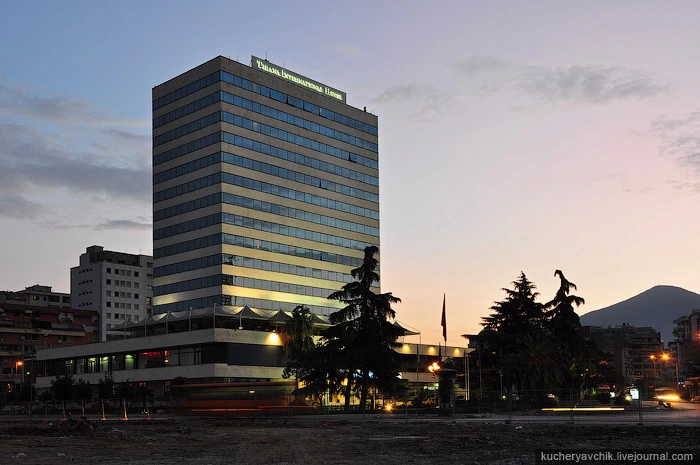
Hotel "Tirana International" - the tallest building in the square of Skanderbeg.
The purpose of reconstruction - to remove vehicular traffic from the main square of the city and make it completely pedestrian. So the power of Tirana want to make their city more attractive to tourists. Sponsor of construction - Bank of Kuwait. In addition to the arrangement of the main square, Bank of Kuwait pays construction of the largest mosque in Albania somewhere nearby.
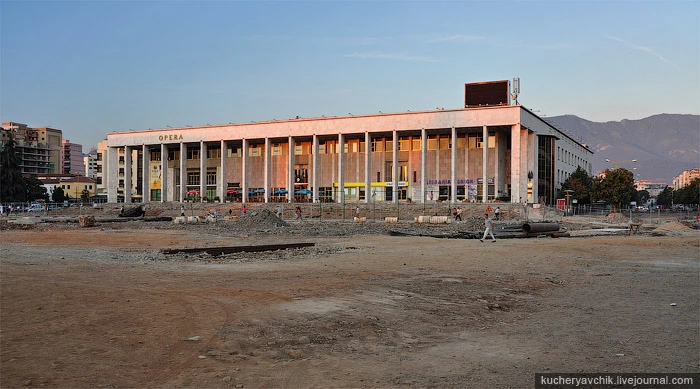
Albanian opera house, a gift of the government of the Soviet Communist government of Albania. After the rupture of relations with the USSR in 1961, the building has long stood unfinished until Albanians not completed his own forces.
About five o'clock in the morning imam called through a megaphone on the minaret of the morning prayer, after which the square the first "larks". For the next hour area gradually filled with people. On duty as a policeman came first, he came to work on a broken bike. Sleepy people in the early morning made a painful impression. They not only did not smile the rising sun, but also very unfriendly looking at the man with a big camera.
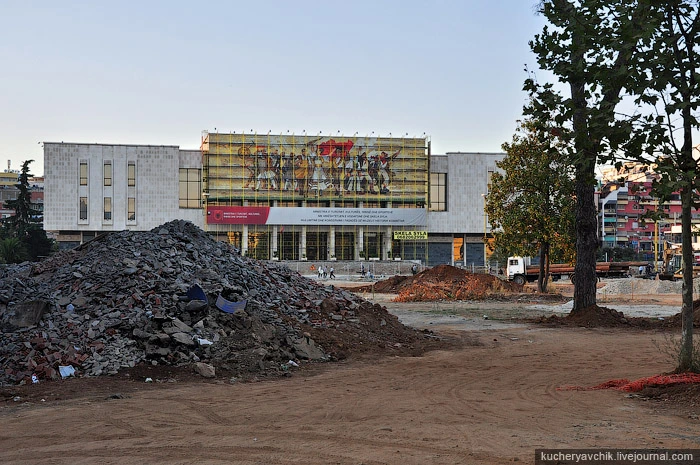
Museum of the History of Albania with berelefom, performed in the best traditions of socialist realism.
Through friends of friends of my friend I lived in a hotel in the western part of Tirana. In my guide did not have a map of Tirana, so it seemed to me that I live on the outskirts of civilization. After downloading a few days ago, photos of a world map, I found out that the hotel is situated at a distance of one vehicle from the center of the ring, that is approximately a 20-minute walk from the central square. Not having a card and do not know the best route, I reached the center of a roundabout way.
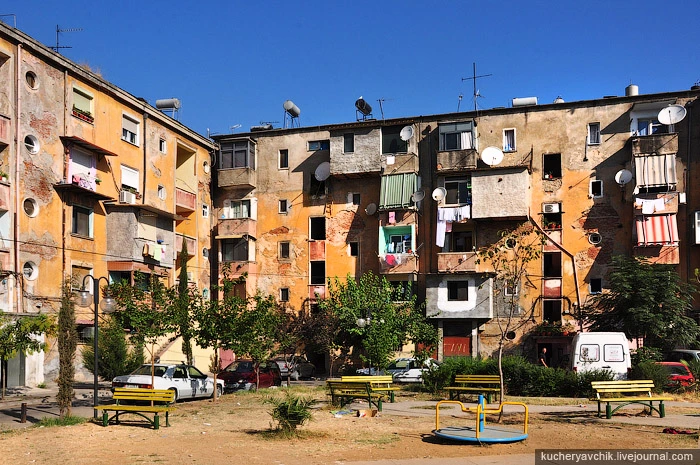
A typical apartment building in Tirana. According to a broken plaster and holes in the windows in the stairwell can be made very accurate conclusion about the average standard of living in Albania.
After breakfast, I went straight to the town of Kruja, that twenty kilometers north of Tirana. To do this, I've been looking for a residential building in which passengers are going to Crouy. About the features of taxi in Albania I detailed in the review report from Albania.
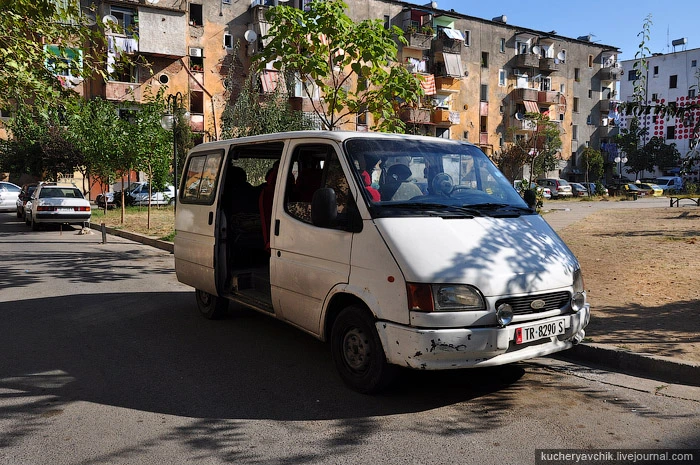
Minibus passengers gather in the courtyards of houses, as there still is free parking. Photo above: bus to the fortress of Kruja in one of the courtyards of the capital.
In Kruja I visited the Museum of Albanian national hero, Skanderbeg, became acquainted with the national life of a wealthy Albanian family in the 19th century ethnographic museum and bought some souvenirs home. Upon returning, I fell asleep and slept until 4 pm. So I managed to avoid the heat.
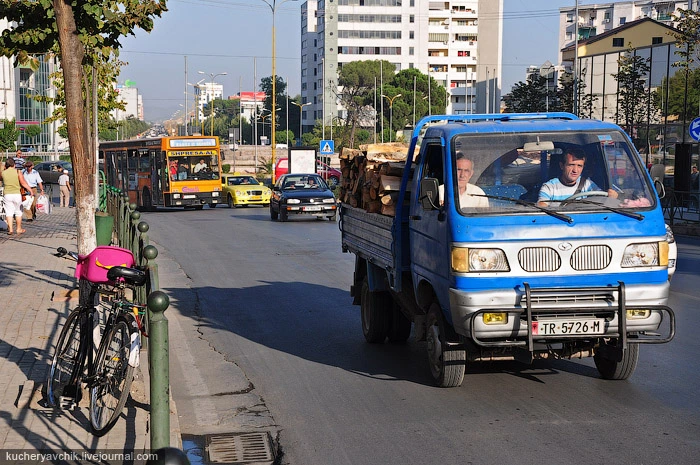
On the streets of Tirana heavy traffic. Drivers not only give way to pedestrians, but it seems to strive to bring down each to set foot on the roadway.
Tirana - very hot city. The average temperature in August reaches 31 degrees here, and during my visit to Tirana, the sun roasted all 40 degrees! I slept through the hottest time of the day, and then took a shower and went to town. To explore the Albanian capital I had all the time to sunset, that is no more than four hours.
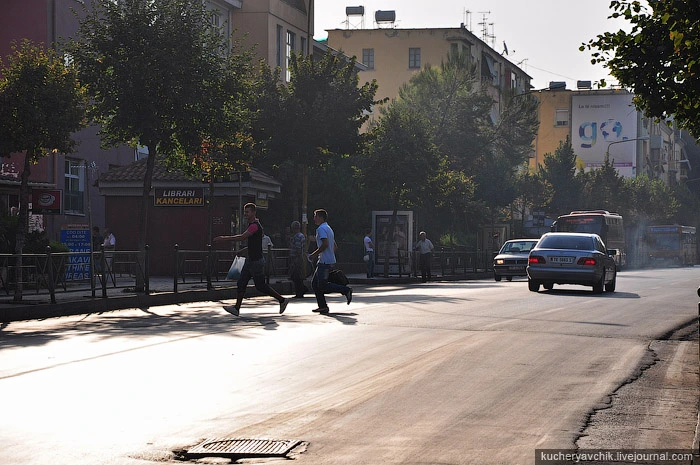
Dust, heat and aggressive drivers are not deterred by pedestrians who need to urgently go to the opposite side of the street.
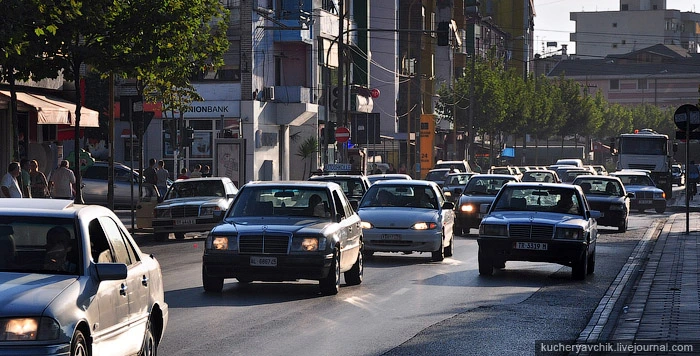
"Mercedes" - the most common car on the streets of Albania. Most of the old "Mercedes" were deported to countries in Western Europe.
Without a map of the city and without street signs I did not know where to go. First I moved to the side of the river, I saw in the morning. The river crosses the city from east to west and divides into two parts Tirana. In the southern part of the city used to be Blloku district, which is home to the political leadership of the ruling regime. Log in Blloku ordinary people was banned. Today Blloku "open and running all day and night" (c). Here, more than in other areas of the city, you can meet foreigners, both tourists and staff of embassies, as well as gold Albanian youth. In Blloku I had dinner in one of the most famous restaurants in Tirana, "Era". I recommend!
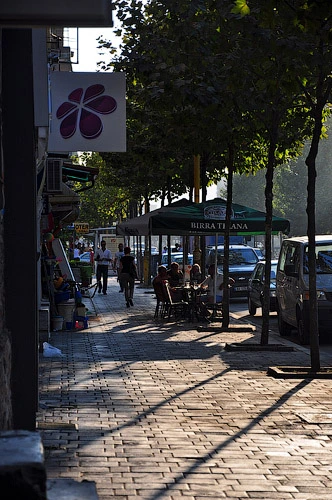
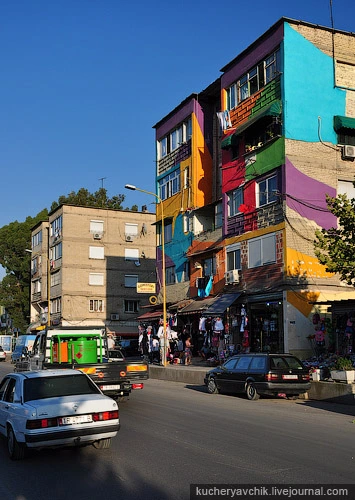
In Albania prevalent lifestyle, familiar to us from traveling to the Middle East: men can recline in a chair for hours, to discuss politics, drinking coffee and playing backgammon.
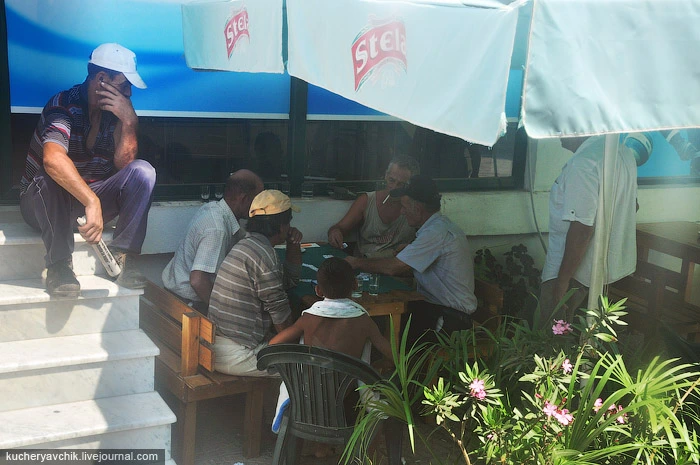
Albanian men play dominoes after dinner.
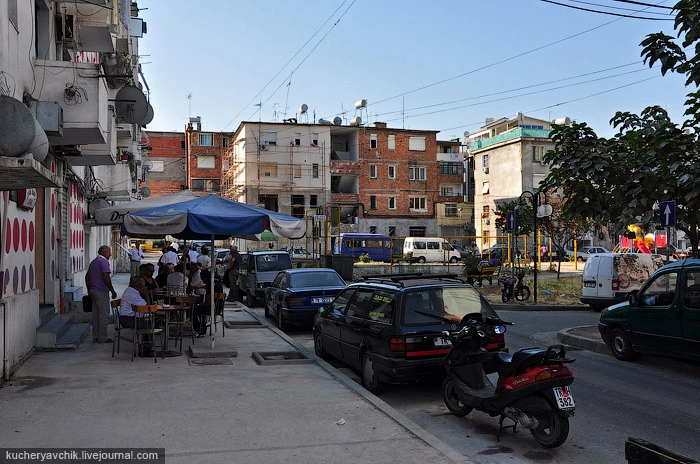
The cafe in the courtyard of an apartment house takes all exchange valuable information.
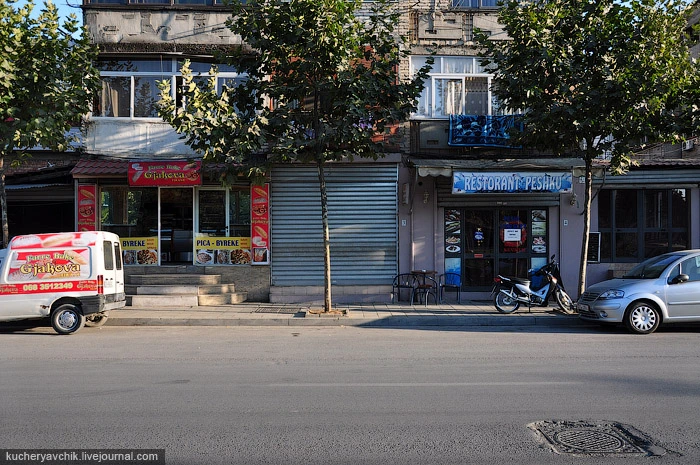
The first floors of buildings in Tirana are reserved for private business. Small business in the city is thriving.
While before dinner I had a few more hours, I began to look for the city center, moving along the river. On both sides of the concrete banks of the river stretched lawn with lawn tonsure, and the river could go to a small bridge, many of which have been pedestrianized. At one of these pedestrian bridges guy selling book "with asphalt" and he was very disappointed that I could take his picture. Photographers in Albania do not like.
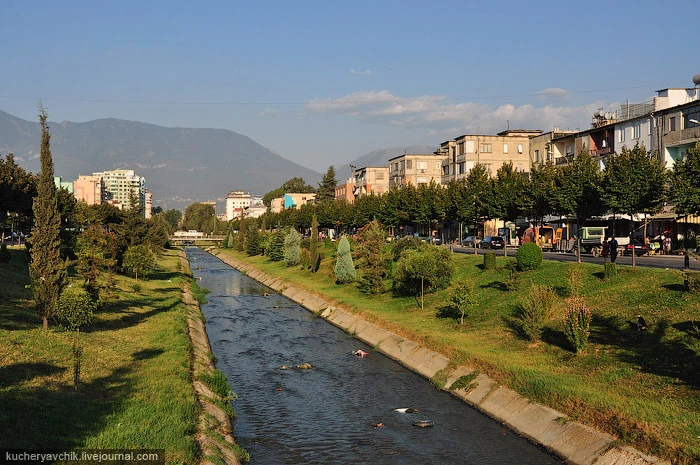
Lana River divides the city into northern and southern parts.
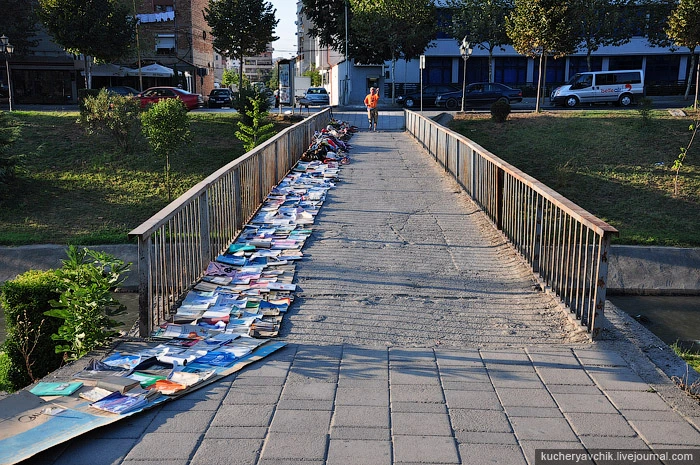
Sale of books on the bridge over the River Lana.
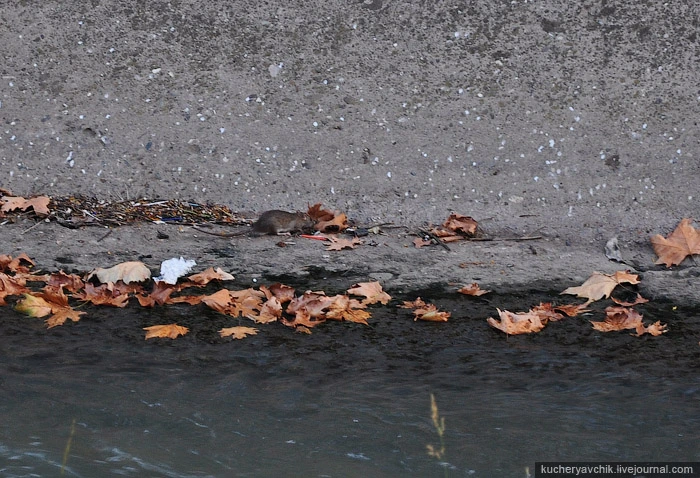
Rat delves into the leaves on the riverbank. In Tirana still very dirty.
In Tirana, very dirty. Due to the turbulent events of the nineties the population of the Albanian capital increased from three hundred thousand to half a million people. Near the river I caught sight of a rat when she dug in the pile of fallen leaves. On the street a lot of dust, the feeling that in the dry hot day only increased. But amidst all this dirt roads divided boulevards with trees and flowering shrubs, and pedestrian sidewalks tiled. In the morning, the road watered. In several places outside the center of my eyes came across signs with tourist information, how to get to the most popular attractions.
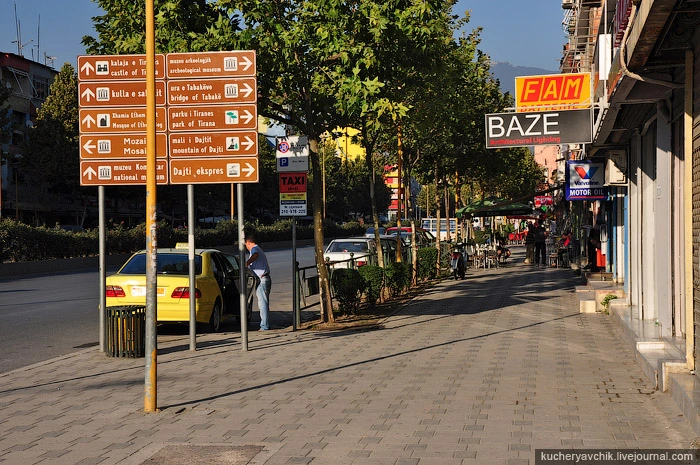
Bilingual direction signs to landmarks on street Kavaja (Rruga Kavaja).
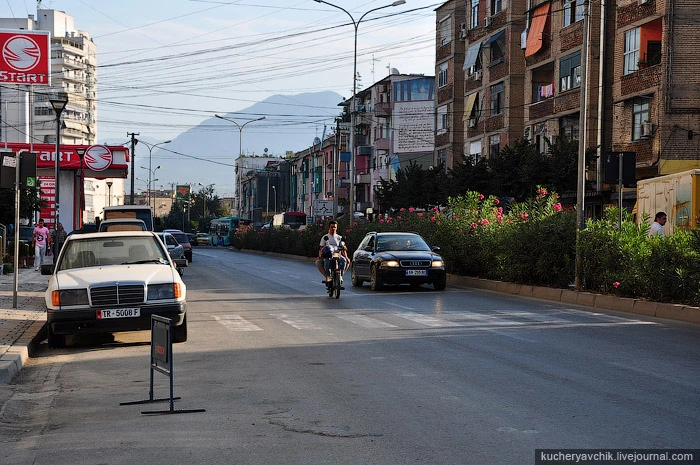
Many avenues of Tirana decorated with flowering shrubs and green alleys.
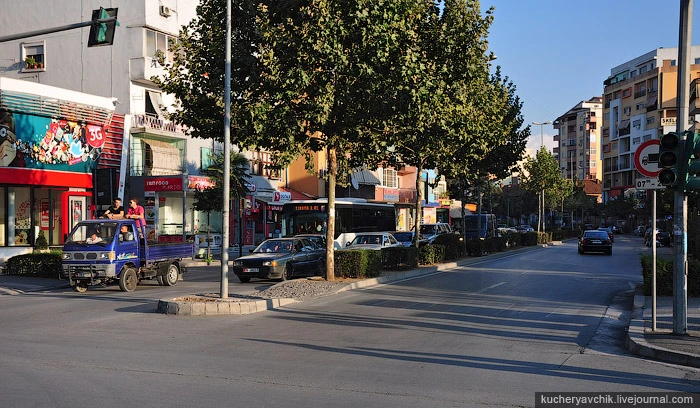
Another boulevard in Tirana on the street Sami Frashëri, the creator of the Albanian alphabet.
The City of Tirana, though mired in corruption and other peculiar politicians sins, still pay attention to the improvement of the city as possible. In Tirana there are no zip codes and house numbers are not written on the facade. But the old apartment buildings, which it would be appropriate to call the barracks, according to the standard of living, put in order, at least from the outside. According to the decree of the previous mayor of Tirana, the facades of many of the old houses were decorated in bright colors and fantastic patterns.
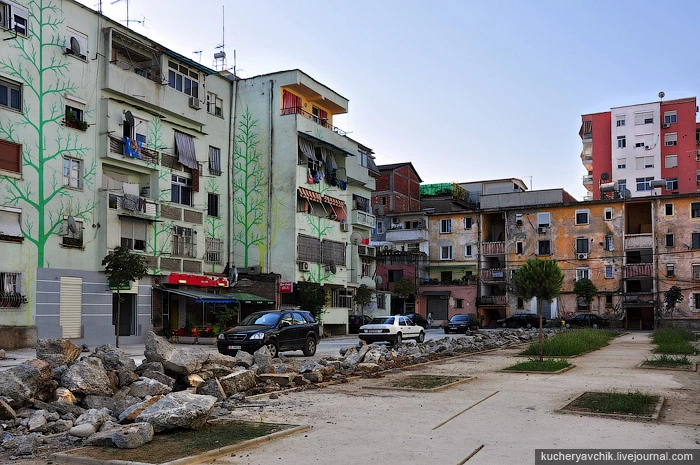
The old quarters of trying to "cheer" colorful patterns on the facades. Inside the house, nothing has changed.
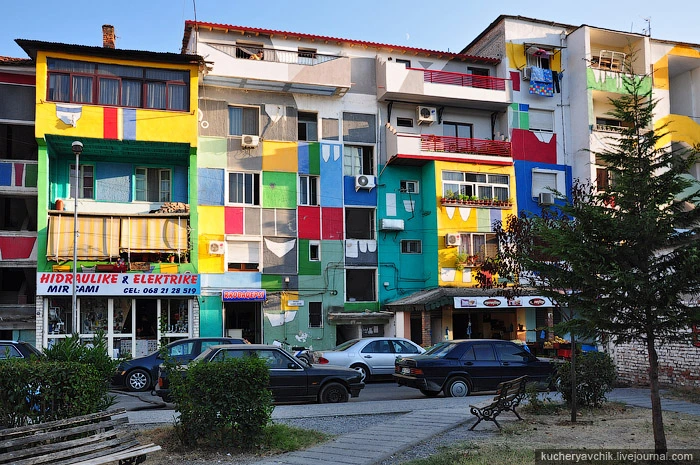
On the facade of the house painted hung clothes that hung in fact not so much conspicuous.
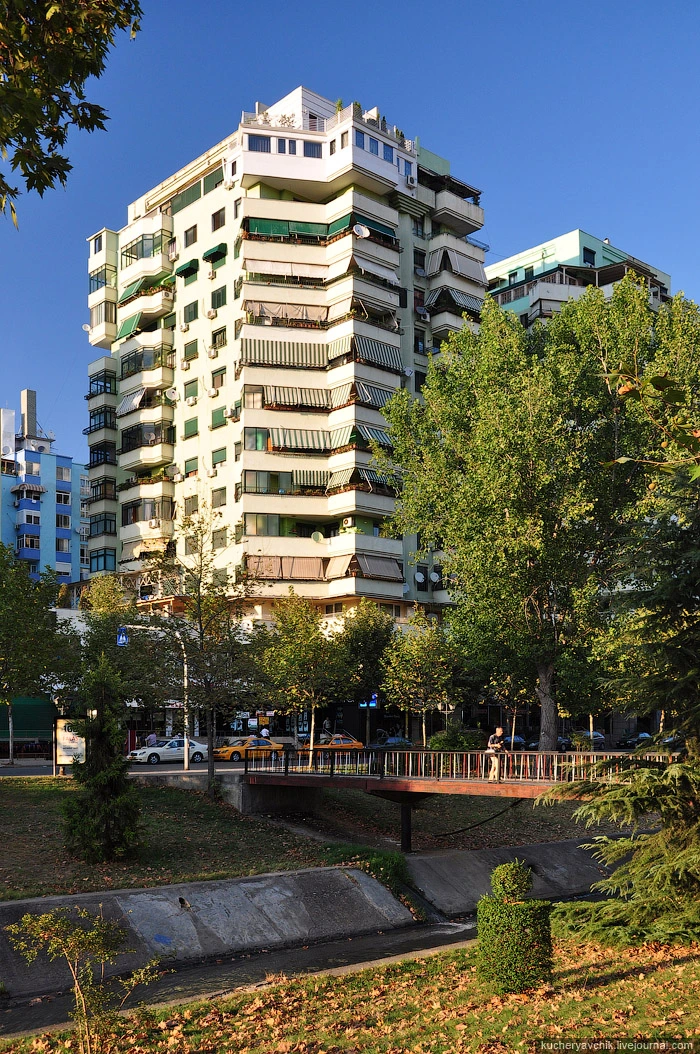
Tirana is experiencing a construction boom. Modern housing is built as high as possible. 25-storey tower TID near the central square of Tirana will soon become the tallest residential building in the city.
In Tirana notice the vast income gap. It would seem that what should be the income gap, so that he caught the eye Kiever! The problem is that in Albania there is almost no industry, and the rudiments of economy built on the principles of administrative-command management system collapsed with the dictatorial regime of Enver Hoxha, barely 45 years old held out a failed political experiment. Poverty was characteristic of Albania in the time of communism. Corruption flourished. In addition to poverty, the Communist government of Albania led highly discriminatory policy towards its citizens. Not only that, the nomenclature and the common people lived in certain areas, the entrance to which was closed, so even the car was the subject of an unimaginable luxury. In 1990, in the whole of Albania, there were only 1,000 cars, they all belonged to the politicians.
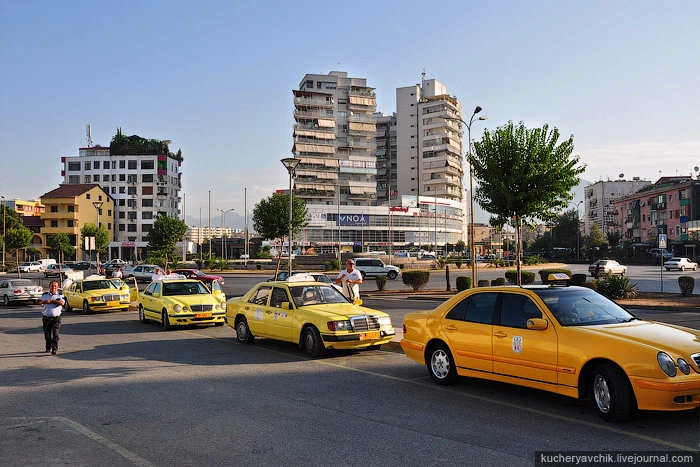
Taxi stand on one of the key areas of Tirana, Karl Topia Square (Sheshi Karl Topia).
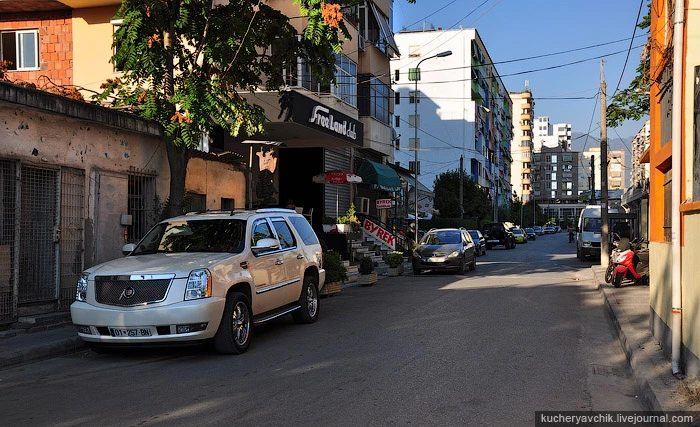
Brand new jeep "Cadillac" in one of the side streets of Tirana.
As we know, the fall of the planned economy spurs the development of wild (!) Of capitalism, as it was in Eastern Europe in the 1990s. Albanian path to capitalism was no exception. In addition to the institutionalized corruption in the country has blossomed theft. In earlier times, theft is punished with imprisonment, in modern times it is indirectly encouraged shattered economic system. In the turbulent 1990s privatized most valuable part of the state property, the rest was looted and put on the scrap. So, for example, happened to the Soviet submarines that people cut and deposited on the metal during the civil war in 1997. Scrap metal were also active railroad tracks.
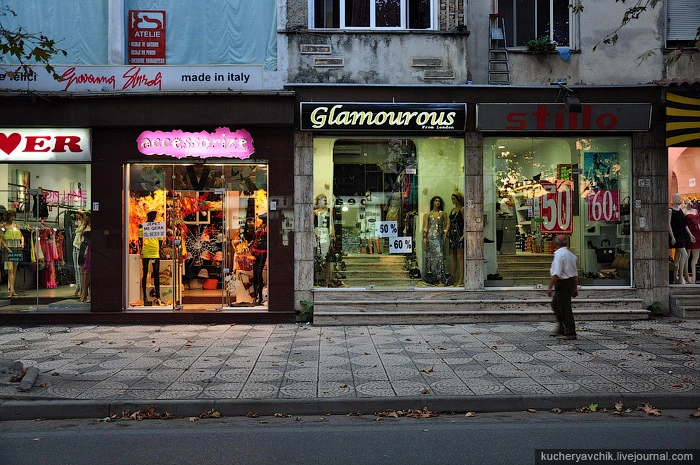
Shopping area in the center of Tirana. Here is a clothing and accessories of all global brands.
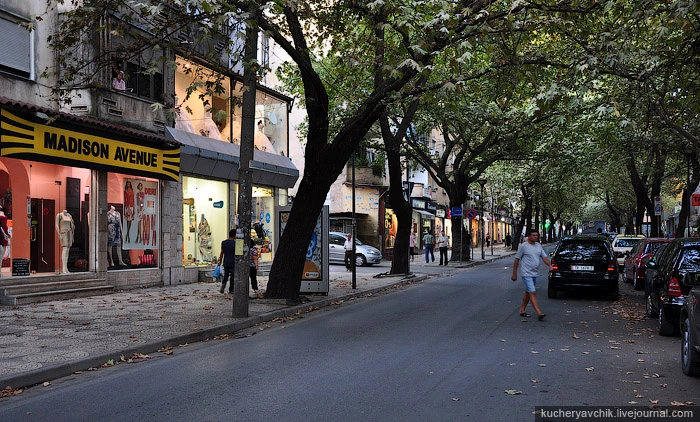
Shopping street Myuslyum Shyuri (Rruga Myslym Shyri) in the center of Tirana.
On the civil war in 1997 should tell apart. After the fall of the communist regime, Albania, like all countries, has decided to follow the path of democracy. Elected governments changed one after the other. All of them featured a thirst for a fast profit and corruption. In 1997, the patience of the people escaped when it was revealed that two-thirds of the country have been victims of pyramid schemes organized by several politicians. Desperate people took to the streets. Aggressive protest acquired the character of armed people started throwing stones at police, smashed shops. Foreign governments urgently evacuated staff of their embassies. For a few months, Albania was plunged into chaos and confusion. Bardak lasted six months. As a result of the events described killed two thousand people.
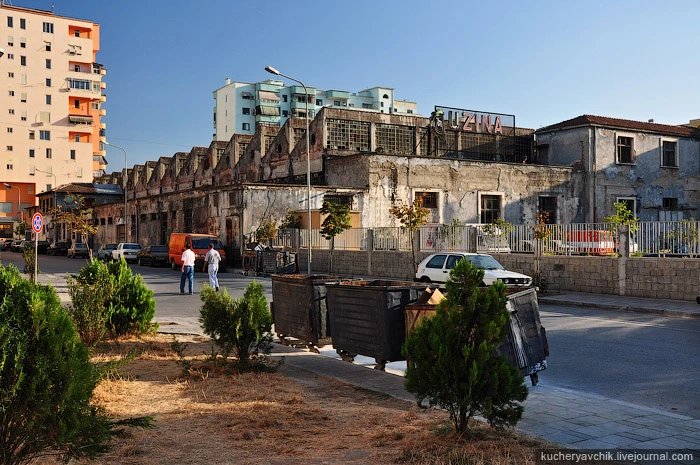
One of the abandoned factories in Tirana. Now on its territory there is a bus station south.
During the riots to discontent defrauded investors MMM-s added the separatist southerners, which once again highlighted the differences in economic and religious composition of the country. Mountainous south developed in less than plains of the north, and because of its proximity to Greece is dominated by the Orthodox, while the northern part of Albania is more industrialized and more Muslim. In principle, the religious factor was not decisive in this conflict, as in the 45 years of communism Albanian people forcibly deprived of religious affiliation. Although Albania is considered a Muslim country, the people in it no more a believer than in any other Eastern European country.
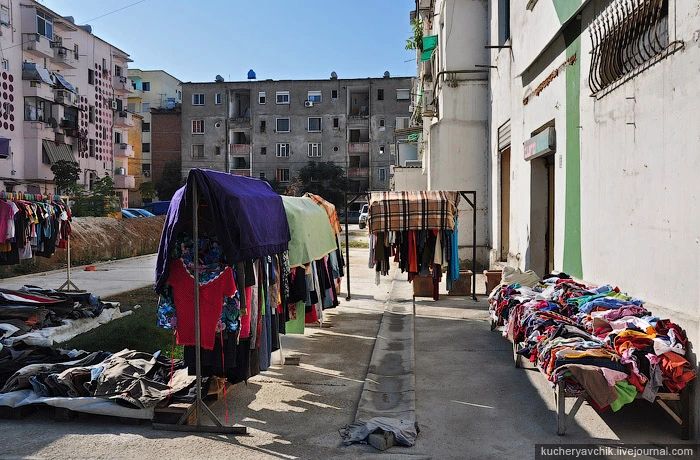
In the courtyards of domovr rspolozheny "magziny" clothing, shoes ...
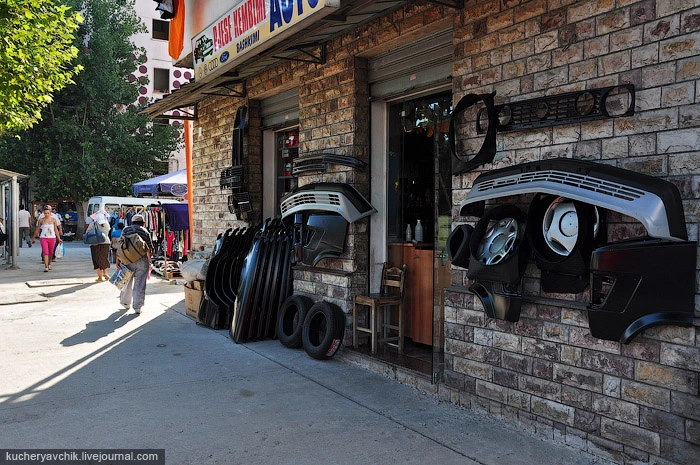
... And spare parts.
Albania - a multi-faceted country, primarily in religious terms. It is impossible not to notice, walked around Tirana. In the main square is a mosque Ethem. Unlike many other temples, the mosque was destroyed during the struggle against religion.
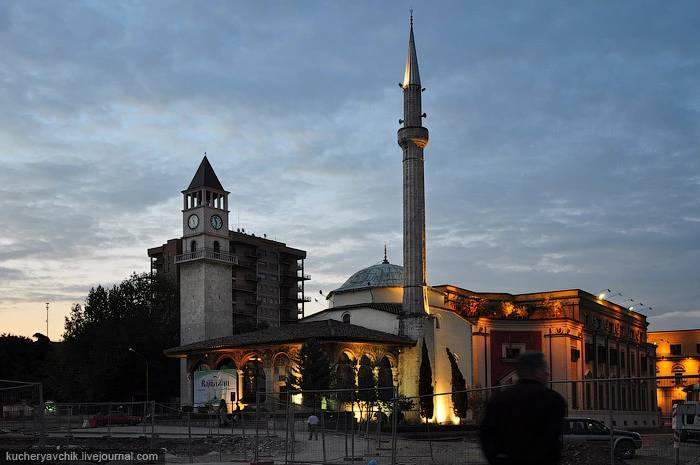
Mosque of Ethem.
Ethem mosque - the oldest building on the square of Skanderbeg. The mosque is famous because it is old, and in Tirana quite a bit of ancient buildings, and the fact that the interior of the mosque is painted "on the grounds of Jerusalem."
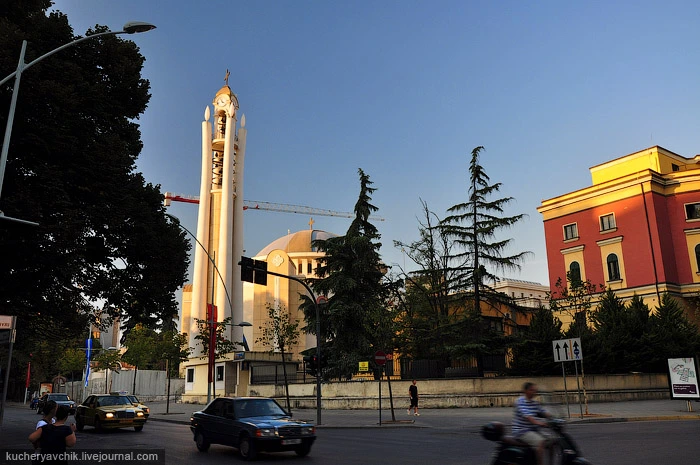
For the trees you can see the construction of a huge Orthodox Church.
In the next block to the mosque being built huge Orthodox Cathedral in the spirit of modern architecture. Construction was started in 2007. During my visit to the exteriors of the temple was nearly completed.
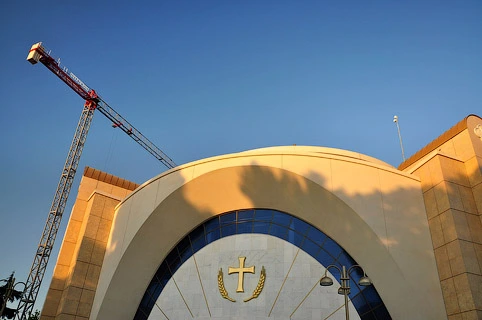
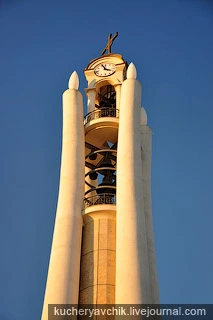
Orthodox Cathedral is built in the spirit of modern architecture, which indicates that the independence of the Albanian Autocephalous Orthodox Church of the more conservative Greek and Serbian churches.
At a distance of a few streets from the Orthodox Cathedral is the Catholic Cathedral of St. Paul, opened in 2001. The interior of the cathedral is decorated with stained glass windows with images of Pope John Paul II and Mother Teresa. Front of the cathedral is a monument to Mother Teresa, an ethnic Albanian Catholic religion, was born in Macedonia.
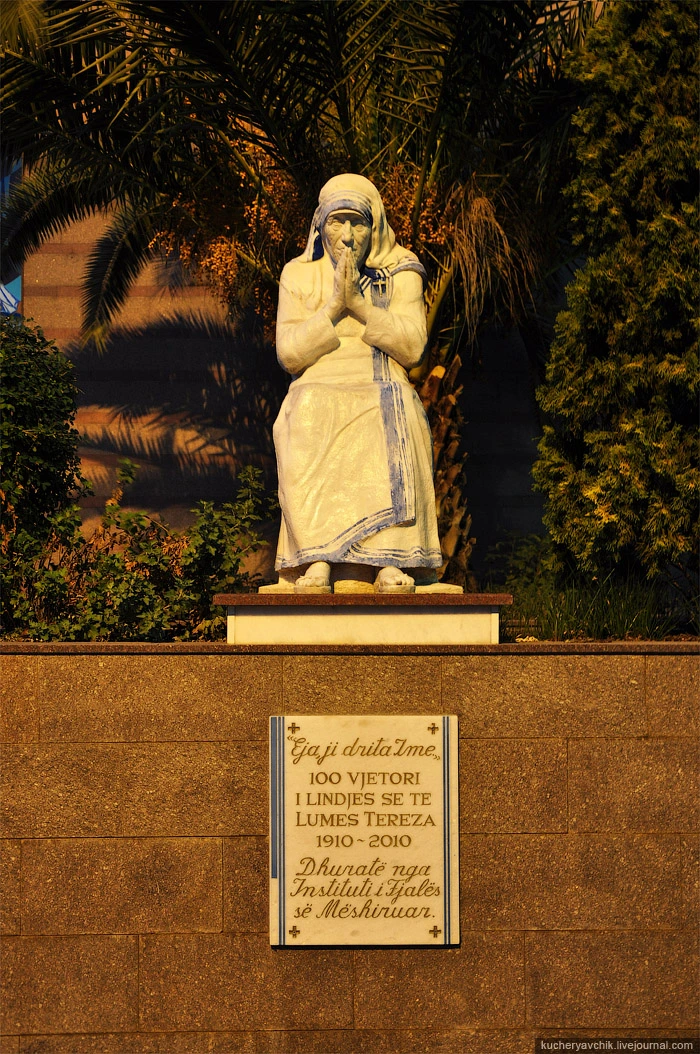
Mother Teresa monument located near the Catholic Cathedral of St. Paul. In honor of Mother Teresa in Albania, Kosovo and Macedonia called a huge number of streets, squares, schools and stadiums.
Tirana is the center bektashizma - liberal branch of Islam, founded in the 13th century. Bektashizma followers are allowed to drink alcohol, and their women are more prominent than in traditional Islam.
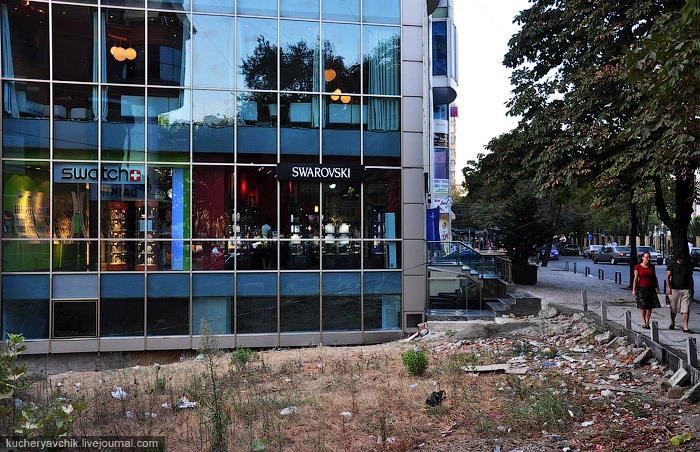
Expensive shops in the center of Tirana.
In the center of Tirana, you can walk along the pedestrian street. Street Murat trampling runs along the remains of the fortress of Tirana. Through schelochku at the gate you can see that in the courtyard of the fortress there is something very secret. The first pedestrian street of Tirana tiled, and along the border in the ground built LED-illuminators, gradually change color from blue to bright yellow.
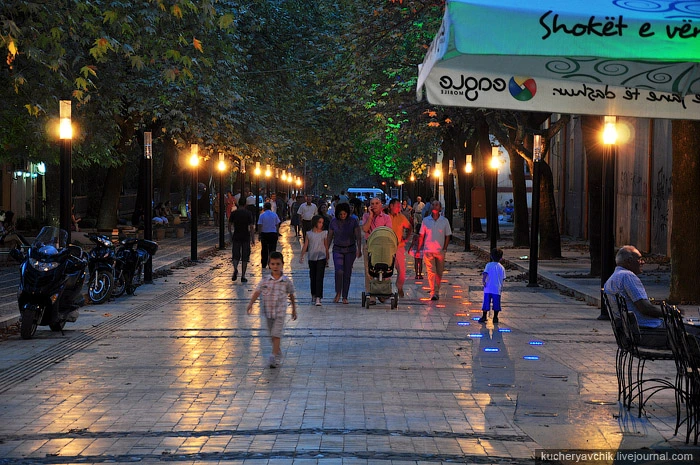
Pedestrian street in the center of Murat trampling Tirana.
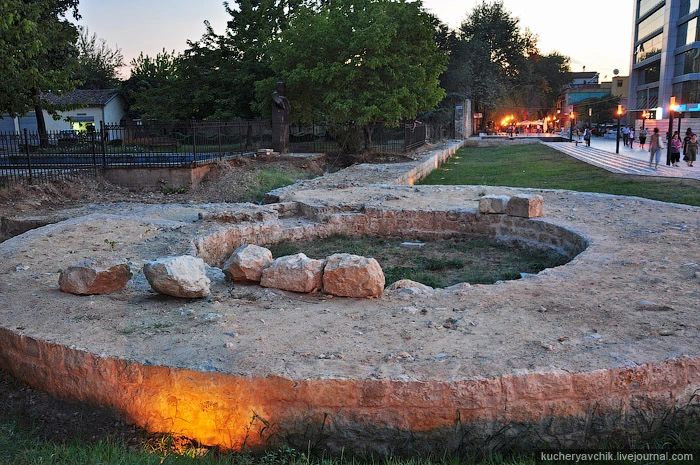
Ruins of Tirana.
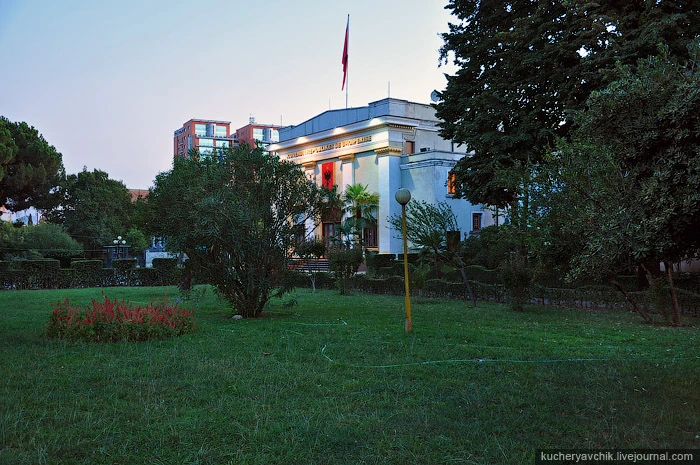
The park is next to the fortress of Tirana hidden the National Assembly building and the Academy of Sciences of Albania. The latter was founded only in 1972.
In the block from the main square is under construction of the tallest building in Tirana - residential building TID Tower. Its height reaches 85 meters. 25-storey building of the Belgian architectural bureau will be the first of a series of high-rise buildings in the capital, Tirana, which should give a modern face. I understand that the construction is carried out literally on top of the tomb of Suleiman Pasha.
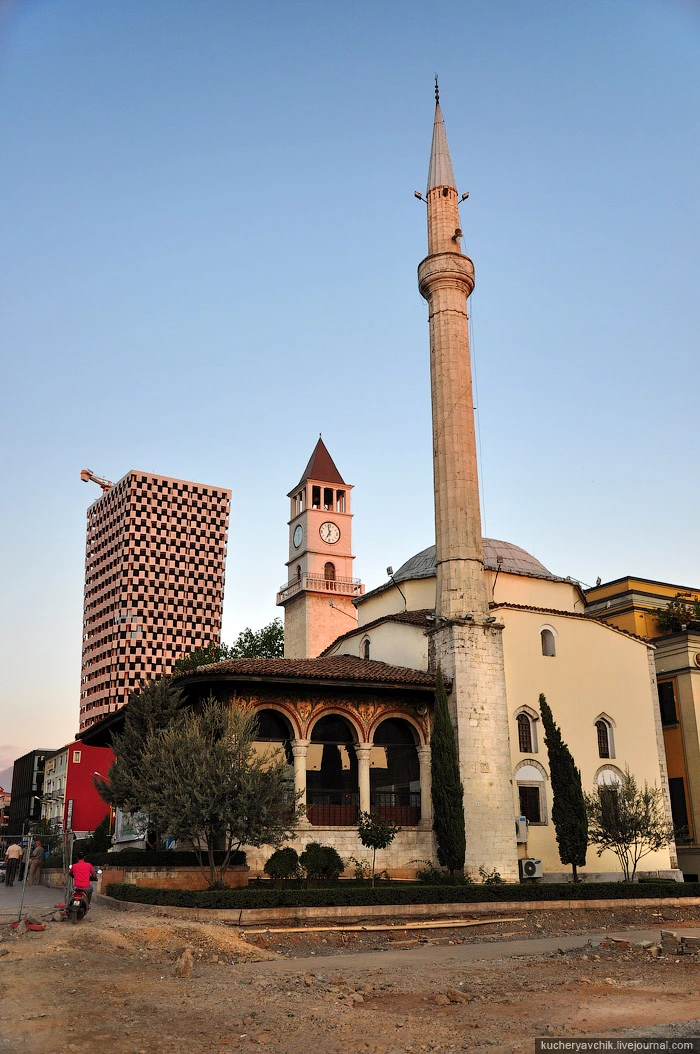
View of the Mosque of Ethem and built residential skyscraper TID Tower.
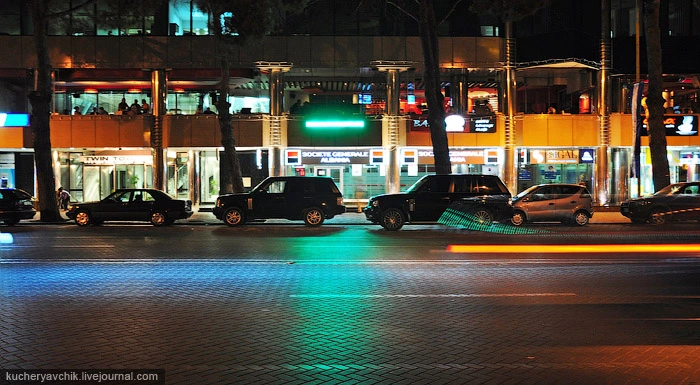
Very luxury shopping mall located on the first two floors of the Twin Towers Twin Towers at the beginning of the Boulevard of the Martyrs (Bulevardi Dёshmorёt e Kombit).
On the opposite bank of the river leads Boulevard Martyrs ending area of Mother Teresa, where the building of the Academy of Arts and the main building of the University of Tirana. Himself Boulevard leaves an ambiguous impression: here is paved roadway paving slabs. In my opinion, this is not the most rational solution to the country where banditry is still a means of survival.
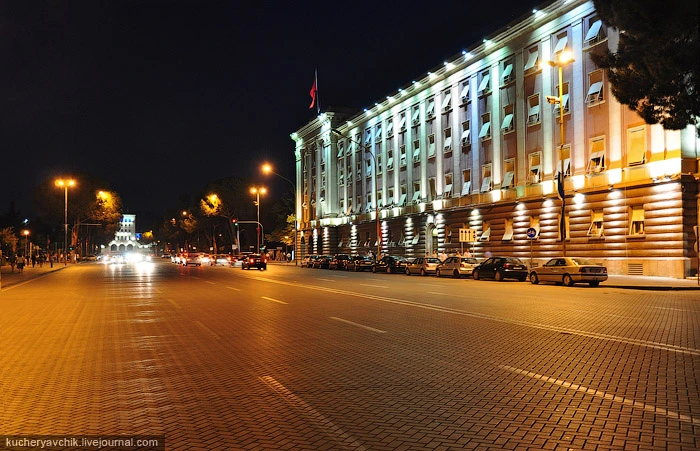
Boulevard of the Martyrs.
Close to the most fashionable quarter of Tirana and the twin towers Twin Towers (in Tirana called the most elite houses English name), youth riding a skate boards in the park around the mausoleum of former dictator Enver Hoxha of Albania. Pyramid-shaped mausoleum was built by the dictator's daughter, but soon after his death it was closed. In the 1990s and early 2000s, it was located in a disco, but now abandoned building.
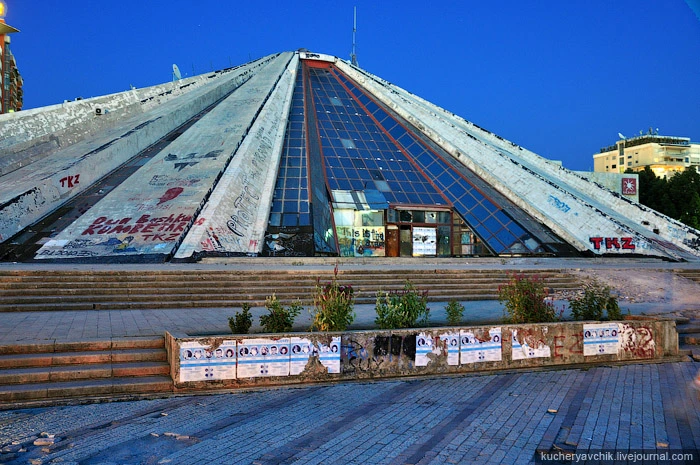
Pyramid of the "leader" of the Albanian people.
I finished a walk in the restaurant "Era" and together with the flow of noisy young people returned to the hotel. The next morning I was waiting for an early departure to the south, to the city of Saranda.
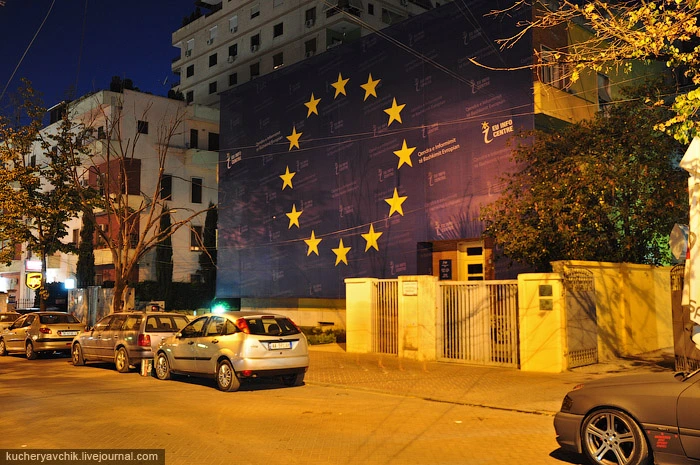
Flag of the European Union closes the facade of the building, which will soon open EU Information Centre. Albania should be considered according to its history. In Europe, the Albanians are clearly associated with avtougonnoy, and an abundance of stolen "Mercedes" on the roads is an ironic smile. Before forming a regular prejudice, we must remember that poverty, through which passed the people of the twentieth century. Greedy and envious looks that I have seen for yourself that early morning on Skanderbeg Square, was not a manifestation of evil in my address, and a statement of extremely poor conditions in which the modern Albanians had to survive. Mixed feelings on the day in the capital could spoil view of all Albania, if I did not go to the south of the country. On the south of Albania - in the following reports!

